Millions of businesses worldwide invest billions in paid ads each year to put themselves in front of as many people as possible. And they're doing it because online advertising, when done right, delivers outstanding results.
On the other hand, if you're not careful, it can feel like flushing your $$ down the digital drain.
To help you out, we've put together this comprehensive online advertising guide for business.
Table of Contents
- What is online advertising?
- How Online Advertising Works
- Benefits of Online Advertising
- Types of Online Advertising
What is online advertising?
Online advertising is promoting your brand, product, or service through various digital channels. It’s an umbrella term that covers social media, display ads, paid and organic search, and native advertising. And it should definitely be part of your marketing strategy.
How Online Advertising Works
Whether you‘re on the lookout for the best Indian restaurant in your neighborhood or looking for a specific SaaS tool, you’re likely going to turn to a search engine to find what you need.
The same goes for your audience.
With search engines like Google, Perplexity, and many others being a core part of daily routines, running paid ads can catch your audience’s attention on these platforms.
And let's not overlook how much time people spend on social media — an average of two hours and 23 minutes each day, according to Statista (though some of us — cough — may be pushing those averages ever higher). In most cases, social media advertising should be part of your overall marketing plan.
There are plenty of ways to advertise your business strategically. First think about who you're trying to reach.
Ask yourself questions like:
- What target demographic am I advertising to?
- How can I place my product or service offering in front of my target?
The answer is to see where your target demographic spends the most time online. Research their most frequented social media channels and the keywords they look up the most.
If you want to run pay-per-click (PPC) ads on social media, it's important to note that most social media platforms offer business pages the ability to pay a fee to promote posts/ads within the interface.
Or, if you are looking to advertise on a search engine for targeted keywords, Google Ads or Sixads can guide you through the process of payment and execution.
To learn more about boosting social media posts, read How to Boost a Post on Social Media [Instagram, Facebook, and Twitter].
If you’re curious about SEO versus PPC, try our article on when to optimize and when to pay for traffic.
Benefits of Online Advertising
There are three key ways that digital advertising can help you improve the performance of your organic marketing efforts.
With digital ads, organic performance can benefit from:
- An increase in brand awareness by displaying your content to individuals within and outside of your networks.
- A better understanding of your audiences by leveraging the targeting and analytics of the ads platforms.
- The creation of higher-performing content by understanding what ad content helps you achieve your business goals and what doesn't.
The goal of any advertising strategy should be to get a positive return on your investment, which comes down to whether you‘re getting more revenue out of the ad campaign than the cost you’re putting in.
To get help on quickly creating high-quality marketing campaigns, try HubSpot’s Campaign Assistant — it can help you generate copy for landing pages, ads, and emails, so you can spend more time on strategy.
Types of Online Advertising
Let's dive right into the different types of online advertising.
Social Media Advertising
Every month, there are over 3 billion active users on Facebook, 2 billion on Instagram, and 586 million on X worldwide.
Because of the sheer number of active users on these platforms, advertising spending invested in social media channels is at an all-time high. The global digital advertising spend is projected to exceed $344 billion by 2027.
When HubSpot asked marketers which social media platforms were best for engagement, we found that Instagram and Facebook take the top slots — but YouTube wasn’t too far behind.
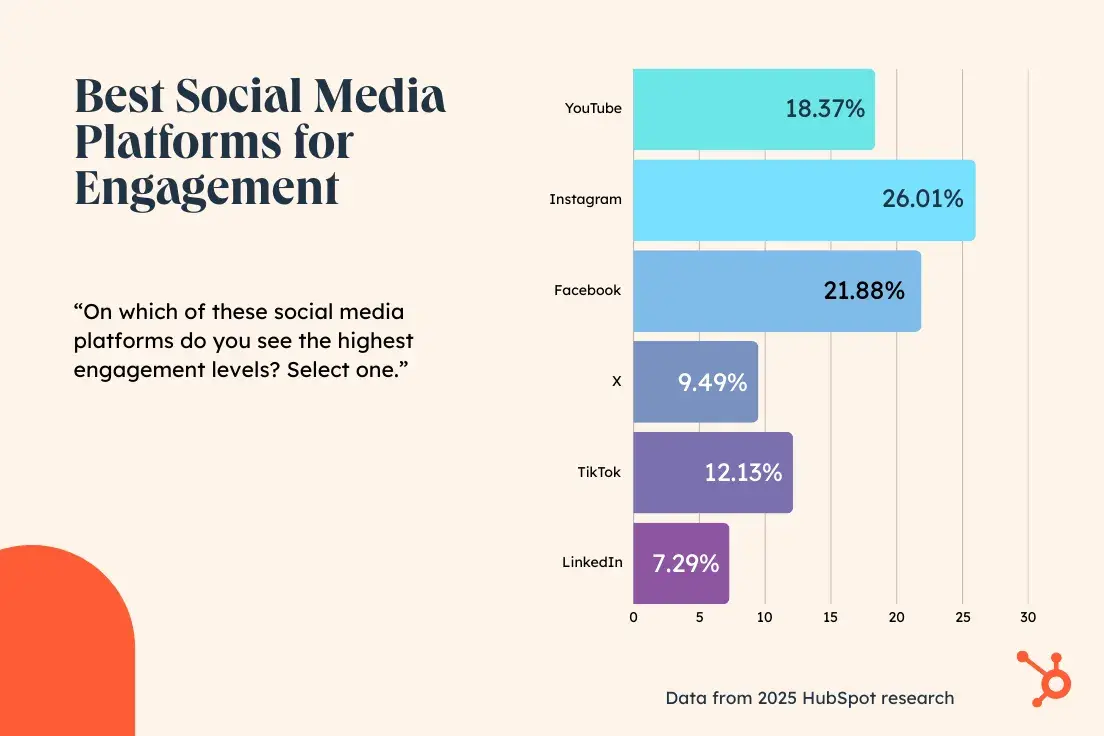
Advertising on social media comes with many advantages. You can:
- Reach very specific target audiences with the help of targeting features and different audiences across all of the social media platforms.
- Leverage a variety of ad formats to advertise in a way that aligns with your business goals.
- Invest in the specific advertising efforts that drive leads and sales for your business.
Let‘s look at eight popular social media networks, including Facebook, Instagram, LinkedIn, X, Pinterest, YouTube, Snapchat, and TikTok. We’ll cover the audiences and ad types available on each one.
In HubSpot original research from 2025, we asked marketers which social media platforms their companies used. YouTube and Instagram were by far the most popular, with Facebook, X, TikTok, and LinkedIn also making the list.
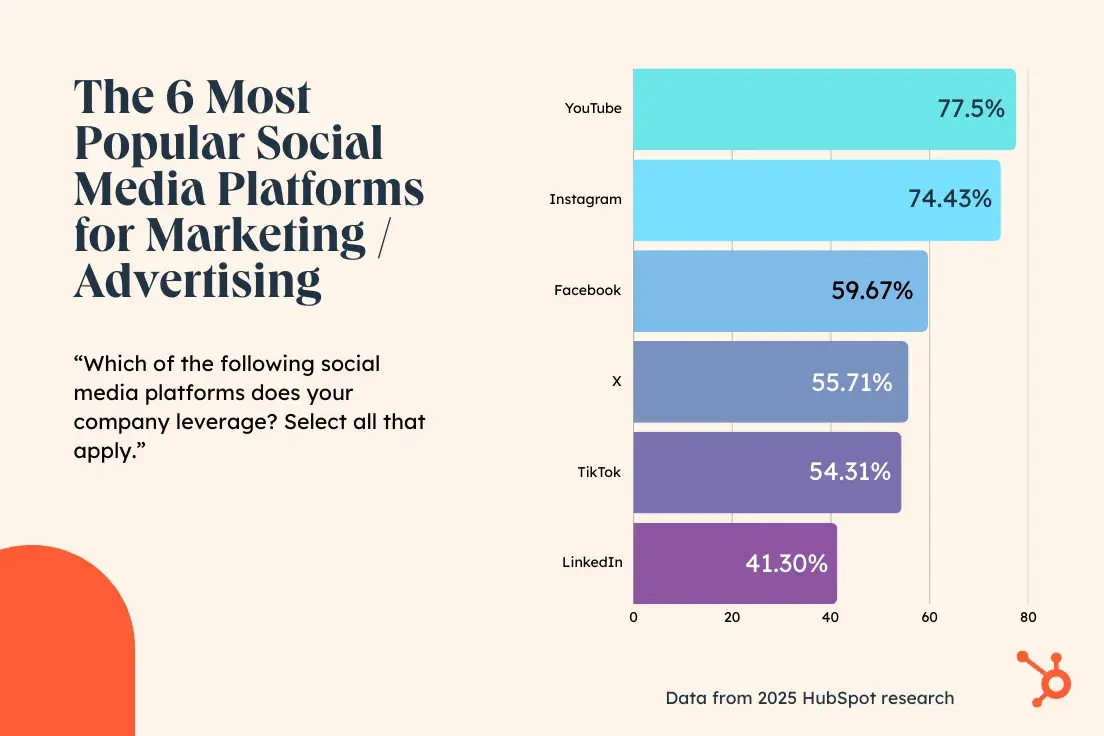
That doesn’t mean you should only focus on one or more of the top six. Depending on your business and your target audience, you may find other platforms just as — or even more — useful.
For instance, digital marketer Jenna Kutcher is a big proponent of Pinterest, which she told HubSpot was the number one organic traffic driver for her business and her most lucrative channel: “The average entrepreneur is spending 20 hours a week on marketing and eight hours on social media,” Kutcher said.
“By comparison, Pinterest takes me under an hour a week, and gives my content a longer shelf life. The average lifespan of a post on Instagram is 24 hours at best. The average lifespan of one pin on Pinterest is four months.”
To learn more about paid social media marketing, read Paid Social Media: Worth the investment?
1. Facebook
According to HubSpot’s 2025 Social Media Trends report, nearly 60% of marketers say their companies are leveraging Facebook.
One of the most powerful features of advertising on Facebook is audience targeting. The targeting capabilities on Facebook are unmatched by any other social media network. Facebook‘s advanced targeting can target your ads to the most relevant audience — and even tap into new audiences you’d otherwise never reach with organic content alone.
Personally, my favorite way to advertise on Facebook is with lead ads because they give you the best of both worlds: sharing visual content and generating leads simultaneously. Facebook lead ads allow you to capture lead information without directing people out of the Facebook platform.
With lead ads, you provide a helpful piece of content that encourages viewers to sign up for a newsletter, receive a price estimate, or request additional business information. In return, when the viewer fills out the form, the business receives a new lead.
Here’s an example that Facebook provides in its lead ads overview:
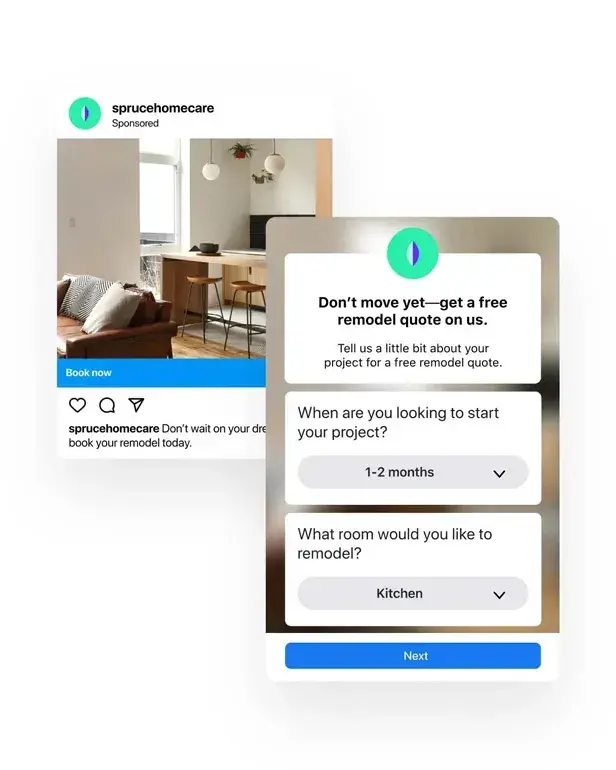
Facebook suggests using three or fewer questions, like in this example, which it says results in a 26% lower cost per lead than ads that ask more than three questions.
2. Instagram
You can also advertise on Instagram through the Facebook Ads Manager. Instagram has over 2 billion monthly users globally, the vast majority of whom are between the ages of 18 and 34.
There are three ways that you can advertise on Instagram:
- Create and promote posts, Stories, and Reels directly from your Instagram professional account.
- Create ads from your Facebook Page and promote them on both Facebook and Instagram.
- Create ad campaigns in the Facebook Ads Manager to access full targeting capabilities.
I recommend taking the third option and creating custom campaigns for your audience on Instagram.
Ads that appear while scrolling your feed are called in-feed ads. The ads that you see in the “Explore” section while exploring your interests and discovering new content creators are explore ads.
In this example provided by Meta, you can see that the explore ad is a 1×1 tile with a “Sponsored” label:
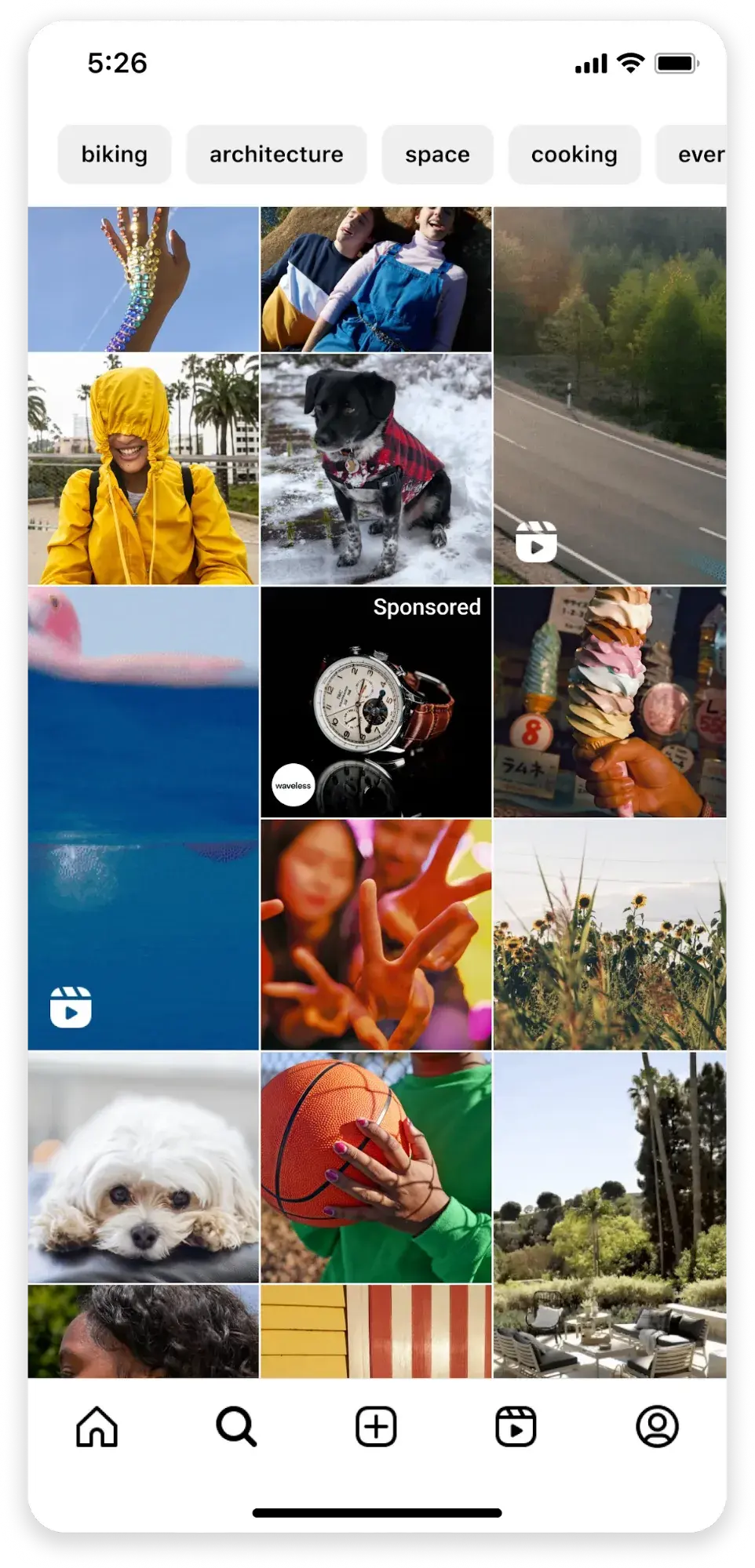
Ads in Instagram Explore are a great opportunity to put your brand in front of people looking for new creators or content.
To learn more, read The Pros and Cons of Instagram Marketing.
3. LinkedIn
LinkedIn has over 900 million monthly active users worldwide.
Users on the platform are largely working professionals, which makes LinkedIn a great place for B2B (business-to-business) advertising.
The advantage of advertising on LinkedIn is its unique targeting capabilities. On LinkedIn, you'll have access to unique targeting criteria that are unavailable on other platforms.
Maybe you only want to advertise to potential customers at the director level who work in customer service within the recruiting industry. LinkedIn's targeting capabilities make that possible.
Plus, with the option to include lead gen forms in your LinkedIn ads, LinkedIn can be a lead generation machine. This will allow you to reach a very specific audience and drive leads without directing them outside of the LinkedIn platform.
In this PDF on best practices, LinkedIn provides the example below of JP Morgan using LinkedIn’s conversation ads:

4. X (formerly Twitter)
Digital advertising is less common on X because organic reach is still a significant driver of a brand's performance on X.
This is very unique to X — but even so, ads can still deliver strong results depending on your goals. X has over 586 million monthly users globally.
If you’re curious about advertising on X, read our post, How to Market on X: Tips and Data from a Marketer.
5. Pinterest
Some say that Pinterest is the only platform where users actually want to see ads from brands they love because Pinterest is all about visuals.
Pinterest has 537 million users who are highly engaged and predominantly female.
Here's how to advertise on Pinterest in four steps:
- Pick a pin. Promote your best pins so they appear in the most relevant places.
- Decide who sees it. Set up targeting so the right people see your ads.
- Pay for results. Choose to pay for engagement or visits to your site.
- Track what's working. Once your campaign starts, see how it's doing and make adjustments as necessary.
Among Pinterest’s case studies is this success story from Kroger:
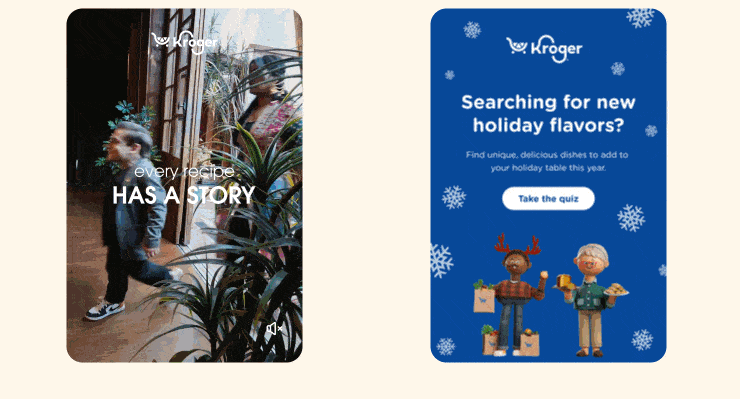
Pinterest says in the case study, “Kroger's efforts paid off in a big way. Premiere Spotlight in search achieved a remarkable 11.6% lift in awareness.1 They also saw a 5.4-point lift in brand association, positioning Kroger as a trusted partner in meal planning.”
6. YouTube
Ads on YouTube appear before and during other YouTube videos or as a stand-alone promoted video that's displayed after performing a search.
Since you can target demographic information and interests, you can serve your videos to specific, relevant audiences already watching videos from similar brands or on related topics.
Learn more about YouTube advertising with our article YouTube Ads for Beginners: How to Launch & Optimize a YouTube Video Advertising Campaign.
7. Snapchat
Snapchat offers a few ad types, including story ads, and augmented reality (AR) lenses — pretty similar to the advertising options on Instagram.
What makes Snapchat unique is the augmented reality lenses. AR lenses are sponsored by a business to create interactive moments that users can use and share with their friends.
For more, read our article Should You Advertise on Snapchat?
8. TikTok
Promoting TikTok videos allows brands to build awareness with a young target audience. Most posts you'll see on TikTok aim to get laughs.
From a brand perspective, you'll want to create funny videos that align with other content on the platform and take advantage of fast-moving trends — think dance challenges and memes. This type of content is the most effective.
HubSpotter Caroline Forsey talked to TikTok’s global head of product partnerships, and they have the scoop on how to use TikTok for lead gen.
Paid Search Advertising
People searching online are looking for something specific and will click on the first result they believe will be the most helpful to them.
You might be thinking: “I already appear in organic results on search engines. Why should I pay to advertise too?”
Well, there are three key reasons:
- Google estimates that for every $1 a company spends on Google Ads, it gets $8 in profit. (You can read about Google’s methodology starting on page 56 of this PDF report.)
- Advertising on search engines protects you from the competition who may be advertising on your branded terms.
- Search ads appear first in the search engine results pages (SERPs) above the organic results.
Paid search advertising allows advertisers to capture the attention of their audience in a more targeted way than with organic search alone.
Search ads allow you to anticipate the wants, needs, and desires of your potential customers and serve ads to them that are highly contextual.
Over time, the analytics of your search ads can help you analyze and improve those ads to reach even more people.
But how does Google know how to deliver the right ad to the right person? That's where keywords come into play.
Keywords
Keyword research is just as important for paid ads as it is for organic search.
That's because Google matches your ad with search queries based on the keywords you selected.
Each ad group you create within your campaign will target a small set of keywords, and Google will display your ad based on those selections.
Let's say Mary is moving to a different house and is looking for a home mover. So she goes into Google and types “who are the best movers.”
By searching “best movers,” she's going to see results for advertisers that targeted keywords like “moving companies” and “top-rated movers.”
Search engines also consider your intent when choosing the types of ads to display.
So, how do you select your keywords?
Keywords typically fall under two categories: brand and non-brand.
A brand keyword is a word or phrase that includes a brand‘s name or variations of a brand’s name. For example, some of HubSpot's brand keywords include HubSpot, HubSpot Free CRM, and HubSpot Marketing Hub.
These are all variations of the HubSpot brand and the tools that we offer.
Non-brand keywords are all other relevant keywords that don‘t include a brand’s name or variations of a brand's name.
Some of HubSpot's non-brand keywords include “inbound marketing,“ ”sales software,“ and ”customer relationship management.”
While these keywords are not part of HubSpot's brand name, they are relevant terms that allow HubSpot to reach audiences interested in eventually making a purchase.
Brand and non-brand keywords play a role in your digital advertising strategy. Brand keywords help you protect your brand from your competitor's ads.
If you don‘t run ad campaigns for brand keywords, you’ll leave your business vulnerable to losing website traffic to the competition who is bidding on your brand keywords.
Non-brand keywords still have a role to play, too. Non-brand keywords allow you to reach new audiences unfamiliar with your brand.
Match Type
When it comes to when your ad is displayed, you don't just want to pick a certain group of keywords and have the ad shown only when those keywords are entered into the search engine.
This is where match type comes in. Since there's an infinite number of ways that people can actually search for one term, Google gives you three match types to choose from: exact match, phrase match, and broad match.
You can even use a broad match modifier and exclude negative keywords to optimize where your ads are delivered.
Let's take a look at each match type:
- Exact match: A keyword set to exact match will only display your ad if the search term includes that exact keyword or a very close variation. Exact match keywords are surrounded in [brackets].
- Phrase match: A keyword set to phrase match will display your ad if the search term contains the same order of the words, but it can also contain additional words. Phrase match keywords are surrounded by “quotes.”
- Broad match: A keyword set to broad match displays your ad when the search term contains any or some combination or variations of the words in your keyword, in any order. Broad match keywords don't include any symbols.
- Broad match modifier: The broad match modifier allows you to select keywords that must be included in the search query for your ad to be displayed. Keywords with a broad match modifier use a +plus sign.
- Negative keywords: Excludes your ads from being shown on searches with that term. Negative keywords include a -minus sign.
Google vs. Bing vs. Yahoo
There are a few advertising platforms out there for search, including Google, Bing, and Yahoo. But Google is by far the most used search engine out there.
Google processes some 15 million search queries each month. With Google leading the search engine market and accounting for 70% of the global search engine market share — 75% in the US — it makes sense for businesses to run Google Ads campaigns.
But this doesn't mean you should entirely rule out advertising on these other platforms.
In some cases, you can achieve impressive results with a smaller ad spend on Bing and Yahoo than you could on Google since there is less competition from advertisers.
My recommendation is to dig into your organic traffic to identify if Bing or Yahoo make up a significant amount of traffic for any given keywords or topics.
This might indicate that advertising for those keywords on Bing or Yahoo could be profitable.
Regardless of where you advertise, the good news is that advertising on all of these platforms more or less work and look the same. So knowing how to advertise on one will make advertising on the others easier.
Native Advertising
Native advertising, or sponsored content, blends in with the publisher’s content, whether written copy or a video (though there should always be some sort of tag that identifies it as paid content).
Here’s an example from Adweek, which regularly publishes pieces in partnership with brands (note the “sponsored content” tag at the very top left of the piece).
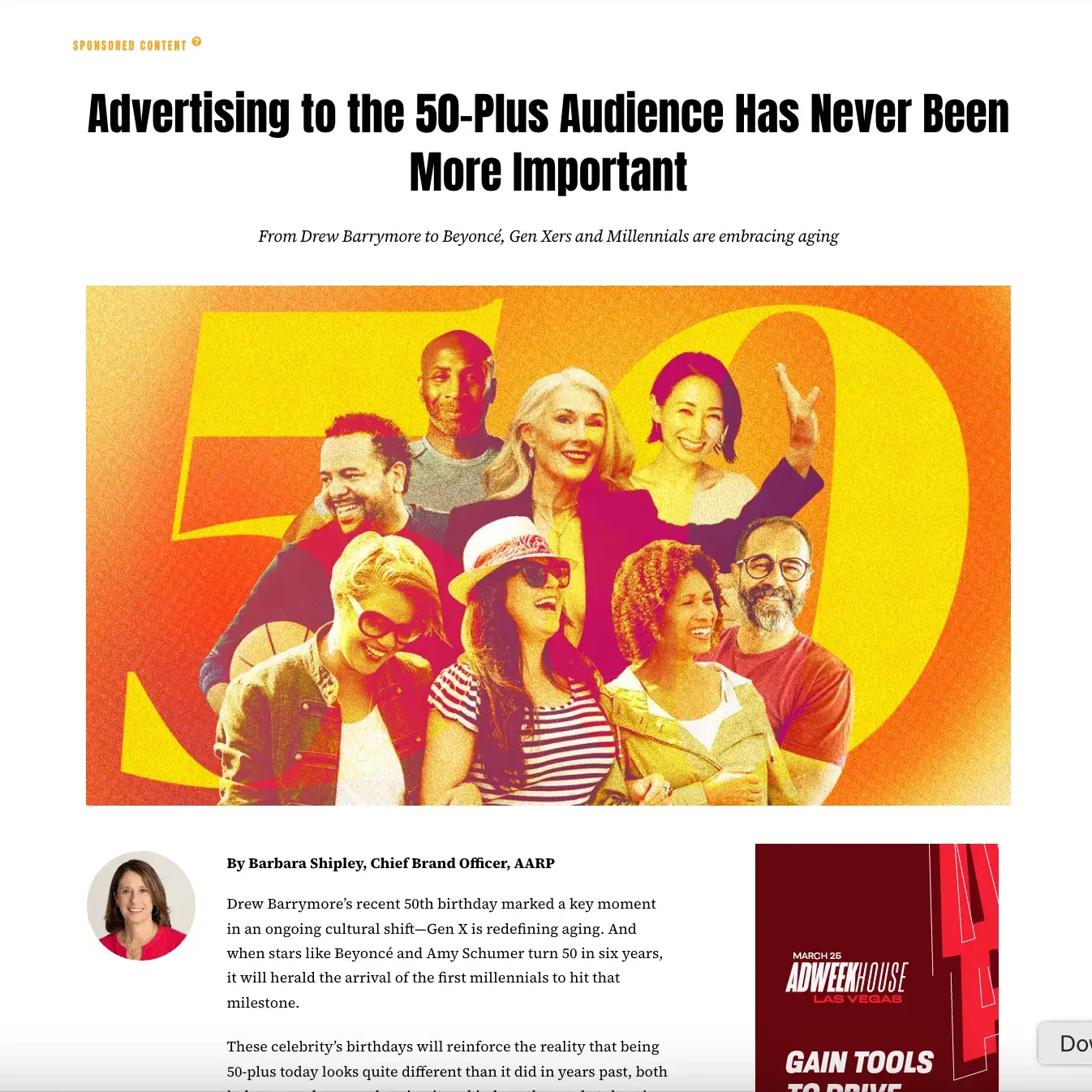
When you pay for a publisher‘s native advertising services, you’ll be able to leverage their editorial expertise and audience reach to help your brand tell captivating stories to a bigger and better viewership.
This way, even though your post is technically promotional, it won‘t disrupt their audience’s browsing experience. They‘ll enjoy reading your post and won’t feel like you or the publisher are advertising to them — exposing your work to an engaged viewership.
And as with the example above, native advertising gives you the opportunity to show up authentically to your audience and give them information that’s genuinely useful to them.
To find the optimal native advertising opportunities for your brand, try using StackAdapt or Nativo.
Display Advertising
Display ads are a controversial topic among digital marketers.
Some advertisers have abused them by tricking internet users into clicking misleading ads, and malicious display ads have even spread computer viruses.
It's easy to see why people use ad blockers: Display ads have a reputation of being intrusive, distracting, and irrelevant.
On the other side of the spectrum, though, display advertising technology has advanced to the point where ad networks can leverage data and machine learning to offer advertisers more effective targeting strategies and consumers more relevant ads.
Ad networks like Google Display Network and Meta’s Audience Network are the leaders in the banner ad renaissance.
They can display your ads to the right target audience at the right place and time.
And if you want more control of your advertising, they‘ll let you decide where to place your ads. Below, we’ll cover each ad network's features and targeting capabilities.
1. Google Display Network
When you use Google's Display Network, you can design visually appealing ads and place them on over 2 million websites and apps, YouTube, and Gmail.
You can also build new audiences by targeting people who are most likely to be interested in your product or service and re-market website visitors just by importing a list of their contact information.
If you don't want to manually build out your ideal audience or deal with bidding, you can let Google Ads do it for you. Its automated targeting and bidding features can identify your highest-converting audience for the best return on investment.
2. Meta’s Audience Network
With Meta’s Audience Network, brands can expand their Facebook ad campaigns and use the same targeting data they use on the platform to advertise on a huge collection of websites and apps.
Brands can place native ads, banner ads, full-screen ads, in-stream video ads, and rewarded video ads (for example, “Watch this video ad to get more tokens!”) on the network's websites and apps that their Facebook audience frequently visits.
If you want to continue leveling up your ads training, check out HubSpot Academy's free course on the Digital Advertising Training Course.
Getting Started
In today's digital work, having the right online advertising strategy is essential for every business.
Now that you know about all of the digital ad types that are available, the next step is to learn how to leverage the right ads for your business to achieve your goals.
Start building a strategy today, so you can increase your revenue tomorrow.
Editor's note: This post was originally published in August 2018 and has been updated for comprehensiveness.




